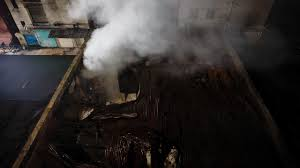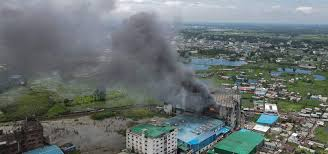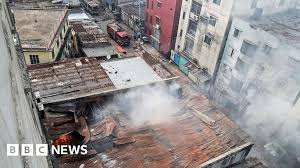A massive fire at a chemical factory in Mirpur has left 16 people dead, with the blaze still raging as emergency teams struggle to contain it. Authorities fear the death toll may rise
A devastating fire erupted on Tuesday in Dhaka’s Mirpur area, claiming at least 16 lives, injuring many others, and leaving the chemical blaze still active late into the night. The inferno began in a garment factory and quickly spread to an adjacent illegal chemical warehouse, sparking an explosion, releasing toxic gas, and trapping workers inside. The scale of destruction, the speed of the fire, and alleged safety lapses have reignited concerns over industrial oversight in Bangladesh’s garment and chemical sectors.
What Happened: Sequence of Events
According to fire service officials, the blaze was first reported around 11:30 am local time in the Shialbari area of Mirpur, Dhaka. The fire quickly escalated, engulfing both the garment factory and the adjoining chemical warehouse.
The garment unit, which housed workers on multiple floors, was overwhelmed by the spread of flames, smoke, and toxic fumes. Bodies were later recovered from the second and third floors. Fire officials reported that locked roof doors, sealed with padlocks, prevented escape upward.
In parallel, the chemical warehouse side remained ablaze and difficult to access. The presence of hazardous materials—including bleaching powder, plastic, hydrogen peroxide, and possibly other chemicals—added complexity to firefighting efforts.
Rescue and firefighting teams, including the Fire Service, police, military, Rapid Action Battalion (RAB), and Border Guard (BGB), mobilised quickly. Multiple fire units (12 units) were dispatched to contain and control the flames. But even by evening, the chemical warehouse fire remained active, sending smoke and toxic gas into the air.
Death Toll, Injuries & Identification

By late evening, authorities had recovered 16 bodies from the garment factory section. Officials cautioned that the death toll might climb further, as search operations in more hazardous zones continued. Some of the bodies were badly burned and in such condition that identification might require DNA testing. Tribune+3bdnews24.com+3
Three severely burned survivors were admitted to the National Institute of Burn and Plastic Surgery. Hospitals also reported respiratory distress in several others, likely due to smoke inhalation. The exact identities of the deceased had not been confirmed at press time.
The recovery operations were hampered by extreme fire conditions in the chemical warehouse, which remained off limits to direct entry for safety reasons. Investigators used drones and remote monitoring tools to survey the site.
Causes, Safety Failures & Red Flags
Preliminary findings suggest multiple layers of safety failures contributed to the high toll. Key issues include:
Locked Roof Doors & No Escape Route
One of the most stark revelations is that the roof doors of the garment factory were locked, with two padlocks, preventing workers from escaping upward as the fire spread below. Fire service officials reported arriving to find those doors still locked. The inability to escape either upward or downward likely contributed heavily to the death toll.
Toxic Fumes & Flashover from Chemicals
Investigators believe that a chemical explosion or flashover in the warehouse released toxic gas, which rapidly spread into the garment building, causing many victims to lose consciousness before the flames reached them. The fire escalated quickly, moving into the “developed stage” and intensifying the threat.
Illegal Operation, Lack of Permits, Absence of Fire Safety Certification
Officials and media reports indicate that the chemical warehouse was operating illegally, lacking trade licences, occupancy certificates, or fire safety clearance. The Department of Inspection for Factories and Establishments (DIFE) also stated that they had no record of that warehouse existing under their oversight. Local city authorities likewise had no record of licensing or approval. According to Rajuk (municipal authority), no occupancy certificate was issued for the warehouse. The garments factory side may have had some formal recognition, but it also lacked proper safety measures and fire‑exit planning.
Regulatory Gaps & Weak Oversight
The incident highlights broader regulatory gaps: thousands of factories and warehouses in Dhaka operate without proactive oversight, making it difficult for authorities to monitor them all. Given the illicit nature of the chemical warehouse, authorities only learned of its existence after the fire. Fire Service officials noted absence of basic safety infrastructure—no proper fire exits, no safety equipment, no clear emergency plans.
Response: Investigations & Official Actions

In the wake of the disaster, the Bangladesh government has moved to respond publicly:
- The Ministry of Labour and Employment constituted a seven‑member committee to probe the fire. Its mandates include determining cause, assessing damage, identifying negligence, and recommending accountability and mitigation.
- The Criminal Investigation Department (CID) has begun gathering evidence from the site, sending samples to chemical labs, and coordinating forensic analysis.
- Fire Service officials continue operations to fully extinguish the chemical blaze and stabilize the area before further entry.
- Local and central authorities have been pressured to explain how an illegal warehouse storing hazardous chemicals operated in a dense residential area without detection. The Business
- Senior government figures, including the chief adviser Muhammad Yunus, expressed grief and directed the provision of assistance to victims’ families.
The investigative committee is expected to submit its report within seven working days.
The Human Toll: Pain, Loss & Uncertainty
Outside the charred ruins, the emotional trauma is palpable. Relatives and neighbours gathered anxiously, clutching photographs, demanding news of their loved ones. Some families spoke of hearing final cries or phone calls before the blaze engulfed the structure. Others still search for missing kin whose bodies have yet to be identified. In many cases, the victims were low-income garment workers—women, migrants, or people with limited social safety nets.
Survivors recount harrowing escapes, coughing through thick smoke, racing past burning walls, and watching coworkers vanish in seconds. The knowledge that locked doors prevented escape deepens the grief and anger in the community.
In hospitals, doctors treated burns, respiratory trauma, chemical inhalation, and shock. Many of the injured remain in critical condition.
Broader Context: Industrial Safety Challenges in Bangladesh

This disaster is not isolated. Bangladesh has a troubling history of industrial accidents, particularly in the garment and chemical sectors—rampant safety violations, poorly maintained buildings, undeclared factories, and unregulated chemical storage are recurring themes.
- In Rana Plaza (2013), over 1,100 people died when a commercial building collapsed, bringing global attention to safety in Bangladesh’s ready‑made garments industry.
- Recent years have seen numerous factory fires and warehouse explosions, often tied to illegal operations or unregulated chemical storage.
- Officials acknowledge that the sheer number of unregistered small factories and warehouses in Dhaka makes monitoring and enforcement extremely difficult.
- Some experts argue that local authorities, city corporations, and regulatory bodies have been negligent, failing to proactively map and inspect high‑risk zones.
This latest fire again underscores the urgent need for stronger regulatory oversight, transparent licensing, stricter enforcement, and accountability for negligent parties.
What Needs to Be Done: Policy, Regulation, Accountability
To prevent recurrence and hold culpable parties to account, several steps are essential:
- Strict Enforcement of Licensing & Safety Certifications
Warehouses dealing in chemicals must operate only with proper trade licences, occupancy certificates, and mandatory fire & safety clearances. Regulators must periodically audit these permits. - Regular Inspections & Monitoring
Factory and warehouse premises in high-risk areas should be subjected to surprise or recurring inspections by independent safety agencies. - Transparent Registry of Chemical Warehouses
Create and maintain a public, up‑to‑date registry of chemical storage sites, their safety measures, capacity, and oversight compliance. - Mandatory Safety Infrastructure
All industrial buildings must have multiple escape routes, unlocked emergency exits, fire suppression systems, ventilation systems to handle toxic gas, and clearly marked evacuation paths. - Relocation or Zoning Regulations
Prohibit chemical warehouses within residential or densely populated areas; require relocation into designated industrial zones away from human habitation. - Whistleblower & Community Reporting Channels
Enable workers, neighbours, or citizens to report unsafe facilities anonymously, without fear of retaliation, and require prompt action. - Legal Accountability & Penalties
Owners, operators, and officials found negligent must be prosecuted. Fines, criminal charges, and civil liability should serve as strong deterrents. - Emergency Response Preparedness
Fireservices must be equipped to handle chemical fires—proper protective gear, chemical suppression agents, gas masks, training for toxic rescue operations. - Victim Compensation & Social Safety Nets
The government must ensure adequate compensation, medical care, rehabilitation, and social support for survivors and dependents of the deceased. - Public Transparency & Prompt Reporting
Authorities should release timely, verified updates to the public to avoid misinformation and to build trust.
Conclusion
The tragedy in Mirpur is a grim reminder of the cost of lax regulation, unsafe practices, and neglect of worker safety. Sixteen lives lost, many more injured, and families still waiting for closure—this is not just an industrial accident, but a failure of governance, oversight, and human decency.
As investigations proceed, the focus must not only be on identifying fault, but on systemic reform to prevent future catastrophes. For Bangladesh, a country whose economy and global standing rely heavily on its industrial sectors, improving safety, transparency, and accountability is not optional—it is imperative.
Also Read : In Egypt, Trump hails ‘good friend’ Modi, then glances at Pakistan PM Shehbaz Sharif















 Categories
Categories








